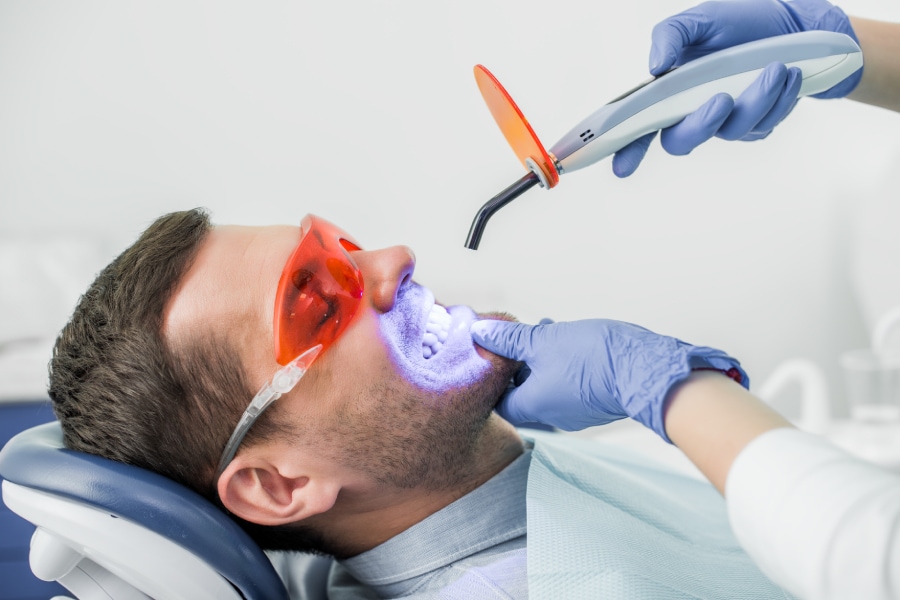
If you find yourself craving pearly white teeth, chances are you have come across two popular methods – dentist teeth whitening and over-the-counter whitening strips.
Both options promise impressive results, but what sets them apart? We’ll explore the differences between dentist teeth whitening and whitening strips to help you make an informed decision on which option is best suited for achieving your desired radiant smile.
Read on to discover the pros and cons of each method, enabling you to keep your smile healthy and bright.
The Benefits and Beauty of Having a White Smile
Having a white smile not only enhances your appearance but also provides numerous benefits. One of the most obvious advantages of having white teeth is improved self-confidence. A bright and radiant smile can significantly boost your self-esteem, making you feel more comfortable and attractive in social interactions.
Maintaining a white smile also contributes to overall oral health. Teeth whitening removes stains and discoloration caused by various factors such as age, smoking, and consumption of certain foods or drinks like coffee or red wine. By eliminating these surface stains, you are ensuring that your teeth are clean and healthy.
Having a white smile can positively impact your professional life too. Studies have shown that individuals with whiter teeth are perceived as more confident, trustworthy, and successful in job interviews or important business meetings. Investing in teeth whitening not only improves your appearance but also gives you an advantage in professional settings.
The beauty of having a white smile lies not just in its aesthetic appeal but also in the psychological well-being it brings along with improved oral health and increased confidence levels both personally and professionally.
What Causes Teeth Discoloration and Staining?
Teeth discoloration and staining can occur due to a variety of factors. The most common causes include the consumption of certain foods and drinks that contain dark pigments, such as coffee, tea, red wine, and berries. Tobacco use is another significant contributor as it contains substances like nicotine and tar that can yellow or darken teeth over time.
Poor oral hygiene practices, such as irregular brushing and flossing or neglecting regular dental cleanings, can also lead to tooth discoloration. Additionally, certain medications like antibiotics (such as tetracycline), antipsychotics, and chemotherapy drugs can cause intrinsic stains that are harder to remove.
Age-related wear and tear on the enamel is another factor in teeth discoloration. As we age, combined with years of exposure to acidic foods/drinks or abrasive toothpaste/brushes, the enamel becomes thinner revealing the dentin beneath which has a yellow appearance.
What is Dental Teeth Whitening and How Does It Work?
Dental teeth whitening is a procedure performed by a dental professional to remove stains and discoloration from the surface of the teeth, resulting in a whiter and brighter smile. Unlike over-the-counter whitening strips, dentist teeth whitening provides highly effective and long-lasting results.
The process begins with an examination of the patient’s oral health to ensure they are eligible for tooth whitening. The dentist will then apply a protective gel or rubber shield to protect the gums before applying a high-concentration bleaching agent to the teeth. This agent breaks down stains and changes their color, leaving behind whiter teeth. In some cases, laser or light therapy may enhance the bleaching agent’s effects.
Dentist teeth whitening offers several advantages over using over-the-counter products like whitening strips. Dentists use professional-strength bleaching agents that are more potent than those found in commercial products. This allows for faster and more noticeable results. Since these procedures are administered by professionals, there is less risk of gum irritation or tooth sensitivity commonly associated with DIY methods such as using ill-fitting trays or improperly applied strips.
Choosing dentist teeth whitening ensures not only superior outcomes but also personalized treatment tailored specifically to your needs for optimum oral health while achieving a radiant smile.
What are Whitening Strips and How Do They Work?
Whitening strips are a popular over-the-counter method for achieving whiter teeth. These thin, flexible strips coated with a bleaching agent are applied directly to the teeth for a specific amount of time, usually once or twice daily for several weeks. The bleaching agent used in whitening strips is typically hydrogen peroxide or carbamide peroxide, which works by penetrating the tooth enamel and breaking down stains on the surface.
The effectiveness of whitening strips can vary depending on factors such as the concentration of the bleaching agent and how well they adhere to the teeth. However, when used consistently and correctly, they can help lighten discoloration caused by aging, smoking, coffee, tea, or other stain-causing substances. It’s important to note that whitening strips may not be suitable for everyone, especially those with sensitive teeth or existing dental issues such as cavities or gum disease.
Compared to dentist teeth whitening procedures, whitening strips offer a more affordable and convenient option. While professional treatments at the dentist’s office can provide quicker and potentially more dramatic results due to their higher concentrations of bleaching agents and use of specialized equipment like laser therapy, they come at a higher cost.
Dentist Teeth Whitening vs Whitening Strips – Key Differences and Similarities.
Dentist teeth whitening involves visiting your dental professional who will use professional-grade bleaching agents to whiten your teeth. This method is highly effective as the bleach used by dentists contains higher concentrations of hydrogen peroxide compared to over-the-counter products. The advantage of dentist teeth whitening is that it can provide faster results, often visible after just one session.
Dentists have the expertise and knowledge to customize the treatment according to your specific needs, ensuring you achieve optimal results.
On the other hand, over-the-counter whitening strips are readily available in most drugstores without requiring a dental appointment. These strips typically contain lower levels of bleaching agents such as hydrogen peroxide or carbamide peroxide and are designed for at-home use.
While not as strong as professional treatments, they still offer noticeable improvements in tooth color when used consistently over time.
In terms of similarities between these two methods, both aim to remove stains from the surface of the tooth enamel caused by factors like coffee consumption, smoking or certain foods and beverages. Both options require regular usage for maximum effectiveness but do not provide permanent results.
When deciding between dentist teeth whitening and whitening strips, it ultimately comes down to personal preference along with budget considerations. If you desire quicker and more dramatic results under professional supervision while having a larger budget for cosmetic procedures – then dentist teeth whitening might be best suited for you.
Cost, Time, and Results
When it comes to cost, dentist teeth whitening typically tends to be more expensive than over-the-counter whitening strips. The price of professional teeth whitening can vary depending on several factors such as the expertise of the dentist, the location of the dental clinic, and the specific whitening treatment used.
On average, professional teeth whitening can range anywhere from $300 to $1,000 or even higher. On the other hand, whitening strips are generally more affordable and can cost around $20 to $50 per kit.
In terms of time commitment, dentist teeth whitening usually requires a single visit to the dental office for an in-office treatment that lasts about an hour or so. This can be followed up with optional at-home touch-ups using custom-made trays provided by your dentist. Whitening strips, on the other hand, require consistent usage over a period of weeks or months for noticeable results. Each session typically takes around 30 minutes and should be repeated daily or as recommended by the manufacturer.
When it comes to results, dentist teeth whitening is often considered more effective in achieving significant changes in tooth color compared to over-the-counter whiteners such as strips. Professional treatments use stronger bleaching agents and customized techniques tailored specifically for each patient’s unique needs and goals.
Whitening strips may produce noticeable improvements but tend to work best for mild discoloration and surface stains rather than deep-seated stains.
San Marcos Dentist – Why Teeth Whitening is the Best Choice for Your Smile
Dentist teeth whitening is the best choice for achieving and maintaining a bright smile. While over-the-counter whitening strips may offer convenience and affordability, they simply cannot match the level of effectiveness and safety provided by professional dental treatments.
One of the main advantages of dentist teeth whitening is its ability to deliver noticeable results in a shorter amount of time. Professional treatments use stronger bleaching agents that can penetrate deep into the enamel, effectively removing stubborn stains and discoloration.
San Marcos teeth whitening offers a personalized approach to meet your specific needs and address any oral health concerns you may have. A comprehensive examination will be conducted prior to treatment to rule out any underlying dental issues that could affect the outcome or cause sensitivity during the procedure. This level of individualized care ensures not only whiter teeth but also optimum oral health overall.
While both options promise whiter smiles, dentist teeth whitening stands out as the superior choice due to its use of professional-grade products, faster results, and customized treatment plans tailored specifically for you.



